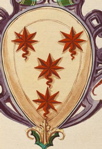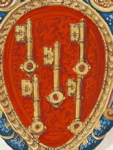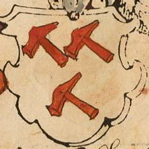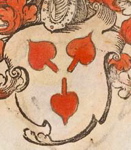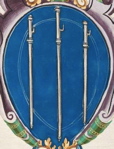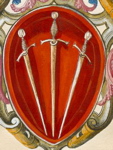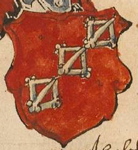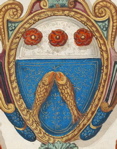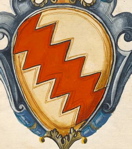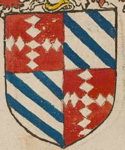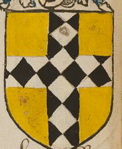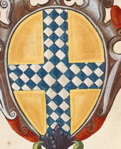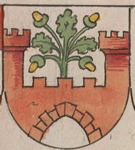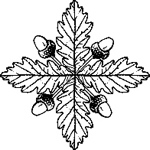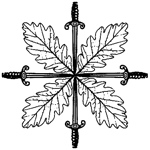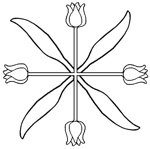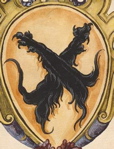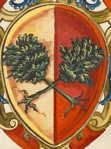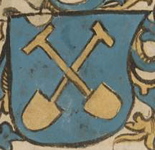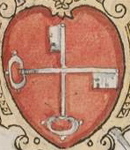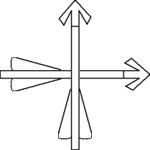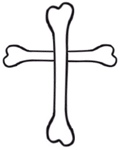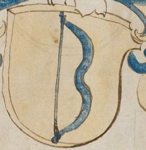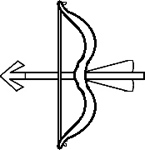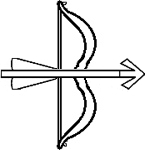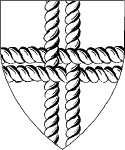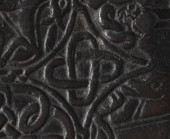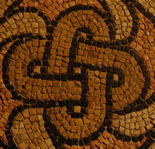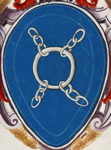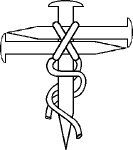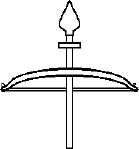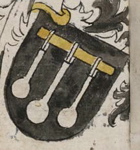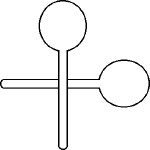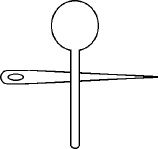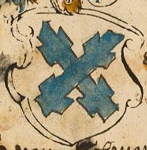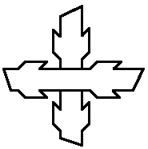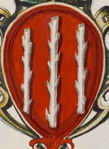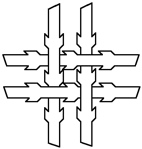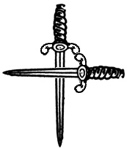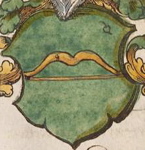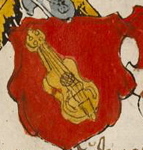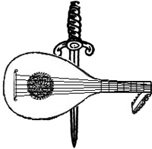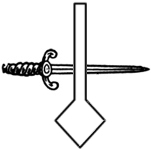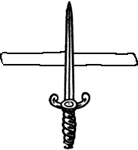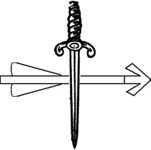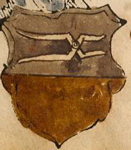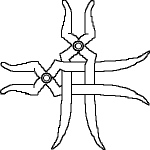|
blazon
|
inspiration / parallel
|
S.C.A.-style emblazon
|
rulings, precedents, and observations
|
|
a cross of four arrowheads conjoined at the points
|
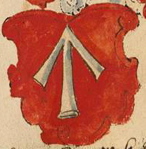
Gules, a broad arrow argent.
BSB Cod.icon 392 d, folio 238r
|
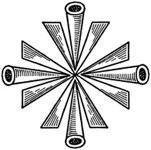
made with the image of a broad arrow on
page
283 of Arthur Charles Fox-Davies' 1909 A Complete Guide
to Heraldry
|
No difference is granted between an arrowhead and a
pheon.
(February,
2007 LoAR)
Note: This cross has a lot in common with a
Maltese cross.
|
|
cross of annulets braced throughout
|
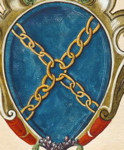
Azure, a saltire of chain Or.
BSB Cod.icon. 270, folio 28r
|

a cross of annulets braced throughout
Volume III of William Berry's 1828 Encyclopædia
Heraldica, Plate XXXVI
|
Note: This has a great deal in common with the registered cross of
chains couped.
|
|
Latin cross of six annulets
interlaced
|

Gules, on a cross swallowtailed Or two annulets interlaced argent.
BSB Cod.icon. 392 d, folio 166r
|
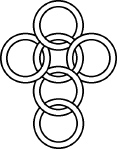
|
Note: This has a lot in common with the registered "cross of
chains couped".
|
|
cross of four anchors conjoined at the ring
|

Or, an anchor gules.
BSB Cod.icon. 392 d, folio 310r
|
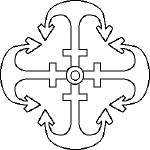
|
A cross of four anchors is substantially different from a cross
crosslet
and significantly different from a cross
potent, but not significantly
different from a cross of
Calatrava
(September,
1990 LoAR). |
|
in cross four birds migrant beaks conjoined
|

Or, in saltire five birds migrant gules.
BSB Cod.icon. 290, folio 36r
|

|
|
|
four drawn bows and arrows conjoined in cross arrowheads outward
|

Bod. MS 264, folio 62v, bas de page
|
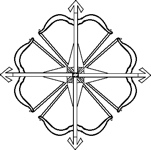
|
Also see the registered cross formed of a bow and
an arrow.
|
|
four caltrops conjoined in cross points to center
|
|

made with the image of a caltrap on
page
283 of Arthur Charles Fox-Davies' 1909 A Complete Guide
to Heraldry
|
|
|
four Cavendish knots conjoined in cross
|
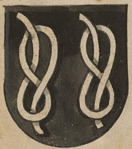
Sable, in fess two Cavendish knots palewise argent.
BSB Cod.icon. 391, folio 15v
|
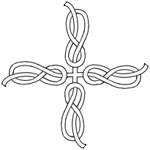
|
This cross doesn't contravene the Society's long-standing ban on
"knotwork" because the conjunction doesn't impare the
identifiability of the constituent charges. "It should be noted,
however, that this badge is probably pushing right to the limits of
the allowance. . .."
(November,
1994 LoAR)
|
|
four crescents conjoined in cross at the points
in cross four crescents conjoined, points inward
four crescents in cross horns to center and conjoined at the tips
|
|
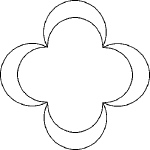
|
Outside the S.C.A., this arrangement is often termed "a lunel".
|
|
four crescents conjoined in cross horns outward
|

Azure, a crescent, an increscent, and a decrescent one and two Or.
BSB Cod.icon. 392 d, folio 293r
|
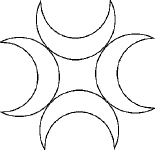
|
This is very similar to the Cross of Caid, which is not a cross
but four crescents conjoined in saltire horns outward, the
named motif of the S.C.A. Kingdom of Caid.
(cover
letter to the November, 2020 LoAR)
|
|
a grenade within and conjoined to four crescents conjoined in
cross at the points
|

Azure, on a bend Or three grenades sable enflamed gules.
BSB Cod.icon. 270, folio 110r
|

made with a modified version of the image of a grenade on
page
284 of Arthur Charles Fox-Davies' 1909 A Complete Guide
to Heraldry
|
|
|
in cross four cubit arms joined at the elbows, hands clenched
|
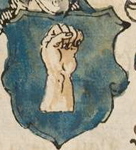
Azure, a sinister cubit arm proper.
BSB Cod.icon. 392 d, folio 319r
|
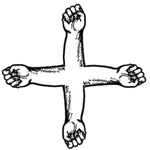
made with the image of a cubit arm on
page
170 of Arthur Charles Fox-Davies' 1909 A Complete Guide
to Heraldry
|
|
|
in cross four double-bitted axes conjoined at the hafts
|
|
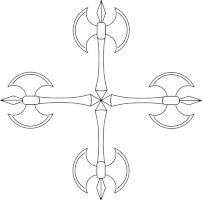
made with the
image
of a double-bitted axe from Christie L. Ward's SVG Images for
Heralds
|
|
|
four dragonflies conjoined in cross tails to center
|
|

|
|
|
four drinking horns interlaced in cross
|

Or, three drinking horns interlaced in pall.
BSB Cod.icon. 390, folio 491
|

|
|
|
four eel-forks conjoined in cross by their bases
|
|
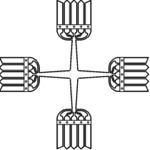
made with the
image
of an eel fork from Christie L. Ward's SVG Images for
Heralds
|
|
|
a cross of four fleurs-de-lys conjoined at their bases
|

Azure, a chevron between three fleurs-de-lys argent.
BSB Cod.icon. 392 d, folio 307r
|
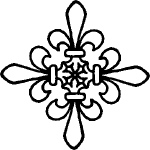
|
Note: This cross has a good deal in common with crosses in
the flory family.
|
|
in cross a rose. . .between and conjoined to four fleurs-de-lys,
bases to center
|

Azure, a rose argent seeded Or and leaved vert.
BSB Cod.icon. 390, folio 46a
|
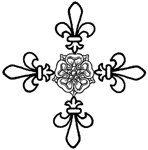
made with the image of a rose on
page
269 of Arthur Charles Fox-Davies' 1909 A Complete Guide
to Heraldry
|
Note: This cross has a good deal in common with crosses in
the flory family.
|
|
four demi-fleurs conjoined in cross
|
|

|
|
|
four hearts in cross conjoined at the points
|

Argent, three hearts gules.
BSB Cod.icon. 392 d, folio 118v
|

|
Note: This cross closely resembles a four-leaved shamrock.
|
|
four hearts conjoined in cross, points outward
|
|
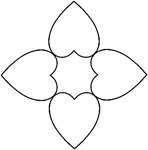
|
|
|
four hearts voided conjoined in cross, points outward
|
|
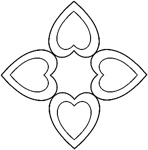
|
|
|
four seeblätter conjoined in cross points outward
|
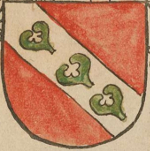
Gules, on a bend argent three seeblätter vert.
BSB Cod. icon. 310, folio 118r
|
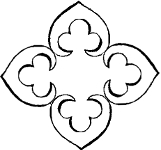
made with the seeblätt on
Plate
381 of the International Heraldry Society's 1952
Vocabulaire-Atlas Héraldique
|
|
|
in cross four horse's heads contourny, necks conjoined
|
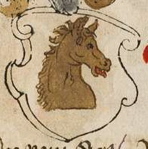
Argent, a horse's head contourny sable.
BSB Cod.icon. 392 d, folio 288v
|

made with a detail from the image of a horse passant on
page
201 of Arthur Charles Fox-Davies' 1909 A Complete Guide
to Heraldry
|
Note: This basic shape of this cross has a lot in common with a
cross gurgity.
|
|
eight keys in cross parted, addorsed in pairs, all conjoined at
the bows by links of chain
This was initially blazoned with "conjoined at the base". The
blazon was corrected on the
February,
2023 LoAR.
|

Gules, a key palewise, wards to chief, argent.
BSB Cod.icon. 392 d, folio 148r
|
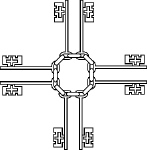
|
Note: This cross has a lot in common with a cross
potent
disjointed.
|
|
four holly leaves conjoined in cross
|

Argent, conjoined in pall three thistle leaves vert.
BSB Cod.icon. 291, folio 33r
|
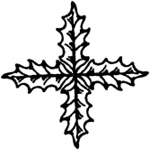
made with a drawing of a holly leaf on
page
329 of James Parker's 1894 A Glossary of Terms Used in
Heraldry
|
|
|
four holly leaves conjoined in cross . . .fructed
a cross of four holly leaves. . .fructed
|
|
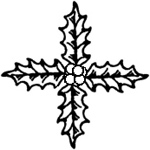
made with a drawing of a holly leaf on
page
329 of James Parker's 1894 A Glossary of Terms Used in
Heraldry
|
|
|
four maple leaves conjoined in a cross, stems to center
|

Vairy vert and Or, on a chief Or two leaves vert.
BSB Cod.icon. 277, folio 84r
|
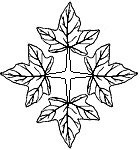
based on
a
drawing of a leaf of Acer campestre in the Az
Erdélyi-medence flóra-adatbázisa.
|
|
|
four maple leaves in cross, stems fretted
|
|
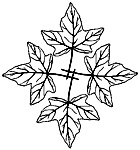
based on
a
drawing of a leaf of Acer campestre in the Az
Erdélyi-medence flóra-adatbázisa.
|
|
|
four oak leaves conjoined at the stems in cross
|
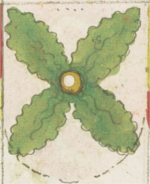
Argent, four oak leaves conjoined in saltire vert.
Herzogin Anna Amalia Bibliothek fol. 220, p. 741
|
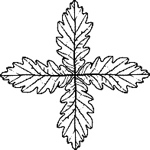
based on an
unattributed drawing of a leaf of Quercus petraea
(Mattuschka) Lieblein on the "Waddington arboretum" website
|
Also take note of the registered cross of oak
leaves conjoined to a saltire of acorns.
|
|
four oak leaves conjoined in cross and fructed
|

Azure, three acorns proper and in chief a label of two points
argent.
BSB Cod.icon., 392 d, folio 326v
|

based on an
unattributed drawing of a leaf of Quercus petraea
(Mattuschka) Lieblein on the "Waddington arboretum" website
and the image of an acorn slipped on
Plate
VIII of William Berry's 1828 Encyclopædia Heraldica,
Volume III
|
Also take note of the registered cross of oak
leaves conjoined to a saltire of acorns.
|
|
four walnut leaves conjoined in cross
|
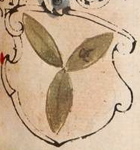
Argent, three leaves conjoined in pall vert.
BSB Cod.icon. 392 d, folio 272r
|

based on an image of Juglans regia leaves from Paul
Graebner's 1918 Taschenbuch zum Pflanzenbestimmen, a
modified
version of which is available under a GNU Free Documentation
License
|
|
|
cross of four lozenges
cross of four fusils
cross of lozenges
Note: The relationship between lozenges and fusils is analogous to
that between an ordinary and its
diminutive.
Fusils are less robust, but exactly where the line is drawn
between them varies.
|

Or, a lozenge gules
BSB Cod.icon. 392 d, folio 296v
|
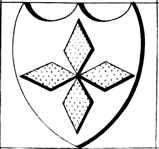
cross of four lozenges
Volume III of William Berry's 1828 Encyclopædia
Heraldica, Plate XXXII
|
A cross of lozenges is substantially different from a
Russian Orthodox cross
(April,
2009 LoAR).
A cross of four lozenges is significantly different from a cross
couped and a
Maltese cross
(April,
1996 LoAR) and from a cross of
mascles
(June,
2003 LoAR).
A cross of lozenges drawn to resemble a mullet of four points may
be in visual conflict with a compass star
(November,
2004 LoAR).
A cross of lozenges is not significantly different from four
lozenges in cross
(October,
2004 LoAR).
Also see information on crosses made up of
mascles and rustres.
|
|
a cross of four lozenges
nowed at the center
|
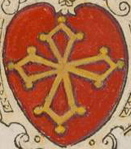
Gules, a Cross of Toulouse Or.
BSB Cod.icon. 333, folio 13r
|

|
This arrangement was originally blazoned as a "cross alchee". It
was reblazoned in the
March,
2010 LoAR because, ". . .a cross 'alchee' does not seem to
exist outside this submission and, therefore, is not
reproducible." At the same time, the sovereigns observed, "The
emblazon of her original armory has the lozenges elongated to
center which is not significant for blazon purposes."
Also see information on crosses made up of
mascles and rustres.
|
|
cross of five lozenges
|
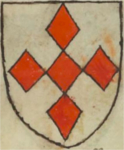
Argent, a cross of five lozenges gules.
BnF ms. fr. 5230, folio 105
|
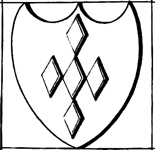
cross of five lozenges
Volume III of William Berry's 1828 Encyclopædia
Heraldica, Plate XXXVI
|
A cross of lozenges is substantially different from a
Russian Orthodox cross
(April,
2009 LoAR) and significantly different from a cross of
mascles
(June,
2003 LoAR).
Also see information on crosses made up of
mascles and rustres.
|
|
a mascle. . .conjoined in cross with four lozenges
|
|
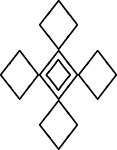
|
Also see information on crosses made up of
rustres.
|
|
cross of four mascles
four mascles conjoined in cross
|

Gules, seven mascles conjoined three, three, and one Or.
BSB Cod.icon. 291, folio 7v
|
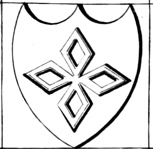
cross of four mascles
Volume III of William Berry's 1828
Encyclopædia Heraldica, Plate XXXVI
|
A cross of mascles is significantly different from a cross of
lozenges
(June,
2003 LoAR).
Depending on how both are drawn in their registered or submitted
emblazons, a cross of four mascles may not get a CD for type from
a compass star.
(November,
2004)
A cross of mascles
pometty is a step from
period practice
(October,
2000 LoAR).
Also see information on crosses made up of
lozenges and
rustres.
|
|
four mascles conjoined in cross, pommetty at all joints
|

Gules, in bend three mascles ployé pomelly.
BSB Cod.icon. 390, folio 350
|

|
A cross of mascles
pometty is a step from
period practice
(October,
2000 LoAR).
Also see information on crosses made up of
lozenges and
rustres.
|
|
cross of five mascles
|

Gules, seven mascles conjoined three, three, and one Or.
BSB Cod.icon. 291, folio 7v
|

|
Also see information on Bowen crosses
and crosses made up of lozenges and
rustres.
|
|
a mascle. . .interlaced with four mascles in cross
|
|
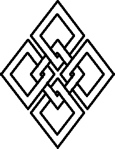
|
Also see information on crosses made up of
lozenges and
rustres.
|
|
a cross of four passion nails
|

Argent, three passion nails sable.
BSB Cod.icon. 392 d, folio 245v
|
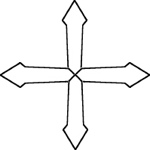
|
Note: Depending on how the nails are drawn, this cross may have a
lot in common with a cross
clechy and/or a cross
barby.
|
|
a cross of four pheons points to center
a cross of four pheons conjoined at the points
four pheons conjoined in cross, barbs to center
in cross four pheons conjoined at the points
|
|
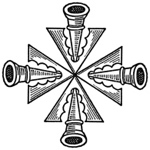
made with the image of a pheon on
page
283 of Arthur Charles Fox-Davies' 1909 A Complete Guide
to Heraldry
|
No difference is granted between a pheon and an
arrowhead.
(February,
2007 LoAR)
Note: This cross has a lot in common with a
Maltese cross.
|
|
four piles, points conjoined in cross
|

Argent, three piles issuant from sinister chief and three from
dexter base all conjoined at the points gules.
BSB Cod.icon. 392 d, folio 296v
|
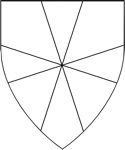
|
Note: This cross has a lot in common with a field gyronny of eight
parts.
|
|
four piles conjoined in cross enarched gurgewise clockwise. .
.fimbriated
|

Gyronny arrondi of six parts sable and argent.
BSB Cod.icon. 390, folio 217
|

|
Note: This cross has a lot in common with a field gyronny arrondi of
eight parts and is reminiscent of a cross
arrondi.
|
|
four quatrefoils saltirewise conjoined in cross, slips to center
and crossed
|
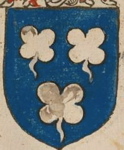
Azure, three quatrefoils argent.
BSB Cod.icon. 291, folio 33r
|

based on the images of a trefoil and a quatrefoil on
page
267 of Arthur Charles Fox-Davies' 1909 A Complete Guide
to Heraldry
|
|
|
four rustres conjoined in cross
|
|
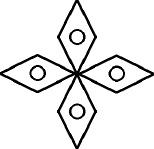
|
Also see information on crosses made up of
lozenges and
mascles.
|
|
a cross of four seaxes conjoined at the pommel
|

Gules, in pale three seaxes fesswise reversed Or.
BSB Cod.icon. 392 d, folio 321r
|

made with the image of a seax from
page
510 of James Parker's 1894 A Glossary of Terms Used in
Heraldry
|
"The semicircular notch at the back of the blade is the
distinguishing feature of a seax."
(September,
1984 LoAR)
No difference is granted between a seax and any other type of
sword
(January,
1992 LoAR).
|
|
cross of four swords conjoined at the points
four swords in cross, points conjoined
cross of swords tips to center
|
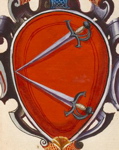
Gules, in chevron issuant from sinister two swords conjoined at
the tips argent.
BSB Cod.icon. 272, folio 134r
|
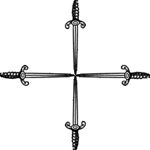
made with the image of a sword on
page
286 of Arthur Charles Fox-Davies' 1909 A Complete Guide
to Heraldry
|
A cross bottony or crosslet
is not significantly different from a cross of four swords
conjoined at the points
(July,
2004). Further, introducing a little space between the points
of four swords in cross, pommels outward, might not be enough to
create a significant difference if they still give the overall
impression of being a single cross
(July,
2005 LoAR).
No difference is granted between different types of swords
(including seaxes, one cross of which has
been registered).
Also take note of the registered cross of
swords conjoined to a saltire of oak leaves.
|
|
four swords in cross conjoined at the pommels
|

Azure, in pall three swords, pommels to center, proper, and on a
chief Or a lion gules between two maunches ermine.
BSB Cod.icon. 291, folio 31r
|
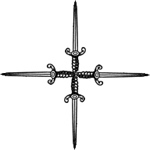
made with the image of a sword on
page
286 of Arthur Charles Fox-Davies' 1909 A Complete Guide
to Heraldry
|
No difference is granted between different types of swords
(including seaxes, one cross of which has
been registered).
Also take note of the registered cross of
swords conjoined to a saltire of oak leaves.
|
|
four Thor's hammers in cross, conjoined at the hafts
|

drawing of a Viking Age pendant featuring Thor's hammer (Mjöllnir)
found at Mandemark, on the island of Møn, in what is now Denmark
page 36 of George Stephens' 1878 Thunor the Thunderer,
Carved on a Scandinavian Font of About the Year 1000
|
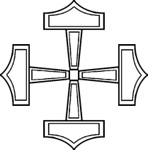
|
Thor's hammer amulets are period artifacts, and the hammers are
depicted in runic inscriptions.. . .Since the amulets are
representations of hammers and tools are depicted in period
armory, their use is not a step from period practice.
(March,
2010 LoAR)
Note: This cross has a good deal in common with crosses
potent.
|
|
a cross formed of six whitebased opals proper
|

This photo of a shaped and polished white-based opal taken by
Ra'ike is available under a GNU Free Documentation License.
|

|
|

